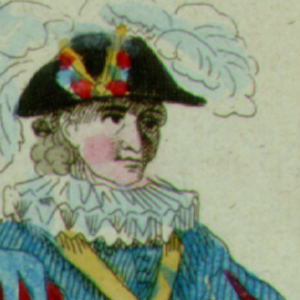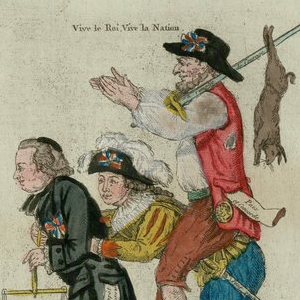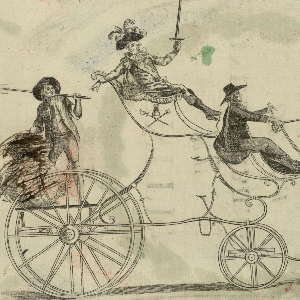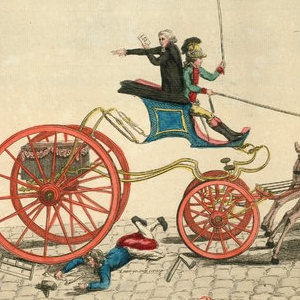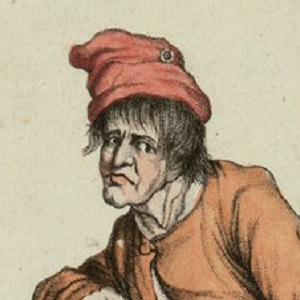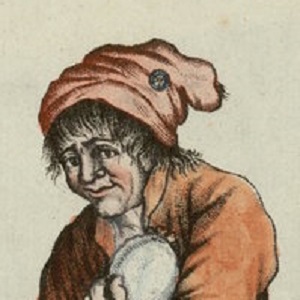Source Collection: Social Causes of the French Revolution
Overview
Instead of bringing unity and a quick, political resolution to the questions of 1789, as intended by its originators, the Revolution was producing further conflicts. What had happened? Had the revolutionaries expected too much? Did the fault lie with the new political elite, because they excluded the lower classes from the optimistic prospects for change? Or did the leaders, despite their commitment to social equality, find it impossible to avoid making private property (and the differences in wealth it necessarily generated) the cornerstone of the new society? The events of the 1790s brought France no closer to determining how and whether social equality could be achieved through political measures. This very issue continues to vex modern society—long after the social stresses of 1789 have dissolved into the dustbin of history. Indeed, it remains one of the most vibrant legacies of the French Revolution.
This source collection includes an informational essay and 53 primary sources.
Essay
A leading cause of social stress in France during the Revolution was its large population. At the beginning of the eighteenth century, France had 20 million people living within its borders, a number equal to nearly 20 percent of the population of non-Russian Europe. Over the course of the century, that number increased by another 8 to 10 million, as epidemic disease and acute food shortages diminished and mortality declined. By contrast, it had increased by only 1 million between 1600 and 1700. Also important, this population was concentrated in the rural countryside: of the nearly 30 million French under Louis XVI, about 80 percent lived in villages of 2,000 or less, with nearly all the rest in fairly small cities (those with fewer than 50,000 inhabitants).
The foremost exception, of course, was Paris, which was home to about 600,000 by 1789. Only a handful of other cities—notably Lyons, Bordeaux, and Marseilles—had more than 100,000 within their limits. These demographics had an enormous impact, both inside and outside France.
In addition, the eighteenth century saw the intrusion of capitalism into everyday life. Thanks to a large expansion of overseas trade and a longer-term development of domestic trade, the money economy experienced continued growth. Although self-sufficiency or local exchange remained the preponderant way of economic life, these incursions of capitalism began drawing everyone into some form of regional and even international exchange.
Amid these broad economic and population shifts, daily life in the countryside remained much the same, particularly on small family farms. Their owners and workers were known as peasants, although they differed considerably in wealth and status. A few could claim to be "living nobly," meaning they rented their land to others to work, but many were day-laborers desperate for work in exchange for a place to stay and food to eat. In the middle were others, including independent farmers, sharecroppers, and renters. Historians have estimated that in lean years 90 percent of the peasants lived at or below the subsistence level, earning only enough to feed their families. Others inhabited the countryside, most notably small numbers of noble and non-noble owners of manors, conspicuous by their dwellings, at the least. Consequently, documents on life in the countryside at this time reflect the omnipresence of poverty. One of the most well-known observers of the late-eighteenth-century French countryside, the Englishman Arthur Young, considered these small farms the great weakness of French agriculture, especially when compared with the large, commercial farms he knew at home. Others commenting on the lot of impoverished peasants before 1789 blamed the tensions between rich and poor on the country's vast social differences.
Although home to the wealthy and middling, cities tended to be even more unsavory places to live than the countryside. Exposed daily to dirty air and water, urban dwellers could expect to have a shorter life span than their country brethren. Louis-Sébastien Mercier, a writer who adored life in Paris and wrote extensively about all aspects of it, often lamented not only the poor health of city workers but also the strict conditions governing their employment. Guilds regulated almost every sector of the economy and thus limited the number who could enter a trade as an apprentice, become a journeyman, or set up a workshop and retail store as a master. With experience, a worker could theoretically move up the social hierarchy, but in practice such ascent was extremely difficult to achieve, as the limited number of masterships in any given industry tended to be passed down within a family. Thus in some trades and in some cities journeymen complained of feeling restricted and expressed greater solidarity toward their counterparts in other trades than toward their own masters.
Bread constituted the staple of most urban diets, so sharp price increases were felt quickly and were loudly protested at grain markets or at local bakers' shops. Most people directed their anger at bread suppliers rather than political authorities, although it was often the municipal and royal authorities who tried to alleviate shortages and prevent such protests. As a result, the credibility and popularity of government officials came to be linked to the functioning of the grain and bread markets.
In addition to economic differences, early modern French society was legally stratified by birth. Its three traditional divisions, or "orders," were the clergy, the nobility, and the common people. Nobles ruled over commoners, but even among commoners, specific individuals (such as officeholders) or groups (such as a particular guild or an entire town) enjoyed privileges unavailable to outsiders. Because these privileges were passed on primarily through inheritance, they tended to constrain social mobility—although without preventing it, since they could also be bought or sold. Thus individuals and groups constantly negotiated with one another and with the crown for more and better privileges. Even as these privileges maintained a close grip on eighteenth-century imaginations, writers of the Enlightenment found them too rooted in tradition and proposed that talent supersede birth as the main determinant of social standing. Even when based on merit, they argued, social differences should not be defined by law, as they were in the old regime's orders. Traditionalists countered that a hierarchy of social orders was necessary to hold society together.
When the King called for an Estates-General in 1789, the social tensions plaguing the old regime emerged as a central issue of the Revolution. Traditionally, estates representatives had belonged to one of the three orders of society, and in principle each order had an equal voice before the King. Because nobles dominated the clergy, however, the majority of representatives actually came from the two privileged orders, even though they stood for only 5 percent of the population at most. Because each voter actually would exercise one vote in the assembly, this configuration allowed the nobility two of the three votes. The King subsequently agreed to double the size of the delegation of the Third Estate, but this move failed to appease critics of the political system. Many pamphlets appeared suggesting that representatives should vote by "head" rather than by "order" (meaning all representatives should vote together as a single assembly, rather than as three separate bodies representing three separate orders).
The purpose of such pamphlets was not merely to win greater representation for the Third Estate. Their authors were making the case for a new concept of society, in which commoners, especially the educated middle classes, had the same value as the other orders. Despite the social rifts surrounding the political debate of mid-1789, most contemporaries fervently sought social unity. This suggests that social unrest may not necessarily have been the basic cause of the outbreak of the Revolution. Indeed, one wonders if the nobility's fear of losing its privileges, rather than the assertiveness of the middle classes, might have been the most important factor in the events that followed.
Far beyond the deputies' meeting hall in Versailles, another kind of social unrest was brewing in the countryside. Upon hearing about the taking of the Bastille, peasants decided they, too, could press for social change through drastic actions. In the summer of 1789 hundreds of thousands mobilized to attack lords' manors and destroy the bitter symbols of seigneurialism: weather vanes, protective walls, and especially property deeds setting forth feudal dues that peasants were required to pay the lord. When news of this rural unrest reached the newly renamed National Assembly in Paris, its deputies, feeling pressured to stay ahead of events in the countryside, responded by announcing the "abolition of feudalism." Their decrees of 4 August represented the first step toward the destruction of the theoretical basis of old regime's system of privileges. Within the year, the assembly would do away with the whole concept of nobility, setting off a vigorous anti noble propaganda campaign in the press.
Urban workers, too, found an opportunity to express their discontent, through elections to the Estates-General. Elections were held in the form of neighborhood gatherings, at which participants collectively designated a representative and compiled cahiers de doléance (lists of grievances) to present to the King, who would communicate them to guide the representatives. Many of these petitions expressed opposition to the privileges of nobles and officeholders. The National Assembly decrees of August 1789 against privilege—which had been the centerpiece of the French social order—were no doubt cheered by the populace.
For all its momentousness, however, the elimination of privilege did not bring an end to the social conflicts underlying the Revolution. Instead, it marked the beginning of another system of social distinctions, set forth in a new constitution introduced by the National Assembly. The most notable of these was the distinction between "active" citizens, who were granted full rights to vote and hold office, and "passive" citizens, who were subject to the same laws but could not vote or hold office. Membership in one class or the other was determined by one's income level, gender, race, religion, and profession. With the Le Chapelier Law of 1791, the National Assembly further differentiated workers from property owners and banned worker associations as being harmful to national unity.
The National Assembly seemed unwilling to grant workers full political and social participation in the new society. One reason for this reluctance was the widespread fear of further unrest. Another was the strong belief among spokespersons for the Enlightenment that only those with a propertied stake in society could be trusted to exercise reason, or to think for themselves. Furthermore, many reform-minded revolutionaries argued that economic-based "combinations" formed by workers too closely resembled corporate guilds and would impinge on the freedom of the individual.
Whatever the assembly's motives, its actions were met with strong opposition. Workers were not untrustworthy or retrograde traditionalists, they retorted, but hard-working, uncomplicated, and honest citizens, unlike the effete and "feminized" rich. Calling themselves sans-culottes to indicate that they wore pants, not knee breeches (a symbol of luxury), they glorified direct action, strength, candor, and patriotism, ideals that radical journalists associated with artisanal work and found lacking in property ownership alone. The fact that such radicals as Elisée Loustallot, Jacques Roux, and Jacques-Réné Hébert were educated men who did not exactly work with their hands for a living led some to question whether their discussions of sans-culottes expressed ideas held by workers themselves. Moreover, one may wonder whether the views associated with the sans-culottes extended much beyond Paris. All the same, the sans-culotte concept took on increasing political significance, because those in authority saw reflected in it the genuine working man. Thus the use of the sans-culotte in radical rhetoric led contemporaries to believe that rich and poor were in conflict throughout the Revolution. How this perception influenced the course of revolutionary events may be seen in the case of Gracchus Babeuf. Before the Revolution, Babeuf had been an agent for seigneurial lords, but after 1789, he became increasingly attracted to the idea of social and political egalitarianism. By 1795, he was leading a conspiracy, although his goals and plans remained vague. Nevertheless, the political authorities worried about class war; they considered him a dangerous egalitarian revolutionary and arrested him. At his trial, Babeuf delivered an inspiring attack on private property and endorsed a system of property sharing that many see as a forerunner of socialism.
In rural areas, social cleavages were as deeply rooted as in the cities. Peasants, in their lists of grievances of 1789, expressed hostility to noble landlords; and, as noted earlier, this hostility intensified after Bastille Day. From July through September 1789, word of the National Assembly's decisions and of the popular revolts in Paris and other cities spread across the French countryside. It was also rumored that frightened nobles were sending groups of armed "brigands" to burn fields, steal crops, and attack villages in order to keep down the peasantry in this moment of crisis. Propelled by what became known as "the great fear," peasants in various regions of France took matters into their own hands, forming armed groups to defend their fields and their villages. The 4 August decrees, largely a response to this upheaval, initially quieted the countryside and soon cemented the peasants to the revolutionary cause.
Like the workers and small property owners in cities, peasants questioned the settlement reached by the National Assembly in 1791. In contrast to Parisian artisans, however, who began pushing for a more far-reaching revolution in 1792–94, large numbers of cultivators hankered for a return to stability in their villages. But this seemed a remote possibility as the Revolution and its wars expanded.
For the peasantry, the foremost cause of instability during the Revolution was the Civil Constitution of the Clergy of 1790. The Civil Constitution, like the Revolution itself, originated in the fiscal crisis that the National Assembly inherited from the crown. Needing substantial revenues, the assembly targeted church lands, which accounted for 10 percent of all landed wealth in France. The legislature divested the church of its property and in exchange took charge of its expenses and administration. The revolutionaries, imbued with the Enlightenment's criticism of the Catholic religion, suspected bishops and archbishops of resisting all change. To ensure the loyalty of parish priests, the assembly (in whose employ the priests now found themselves) added to the Civil Constitution a requirement that all clergy swear an oath of allegiance to the nation. However, almost half refused to do so. Because most "refractory priests" (those who refused the oath) lived in the countryside, the Civil Constitution—designed to promote national unity and prevent religion from becoming a source of resistance to the Revolution—instead generated considerable resentment among the peasantry. This resentment increased with the decree of 9 March 1792, authorizing the confiscation of grain to prevent "hoarding." Chapter 7 shows how this early hostility developed into an armed counterrevolution.
Thus in both towns and countryside, it seemed that the Revolution was not producing the hoped-for results. Instead of bringing unity and a quick, political resolution to the questions of 1789, as intended by its originators, the Revolution was producing further conflicts. What had happened? Had the revolutionaries expected too much? Did the fault lie with the new political elite, because they excluded the lower classes from the optimistic prospects for change? Or did the leaders, despite their commitment to social equality, find it impossible to avoid making private property (and the differences in wealth it necessarily generated) the cornerstone of the new society? The events of the 1790s brought France no closer to determining how and whether social equality could be achieved through political measures. This very issue continues to vex modern society—long after the social stresses of 1789 have dissolved into the dustbin of history. Indeed, it remains one of the most vibrant legacies of the French Revolution.
Primary Sources
Credits
From LIBERTY, EQUALITY, FRATERNITY: EXPLORING THE FRENCH REVOLUTION, https://revolution.chnm.org/exhibits/show/liberty--equality--fraternity/social-causes-of-revolution


